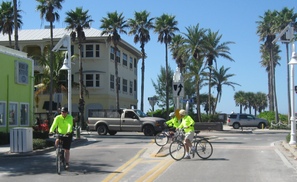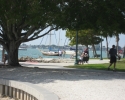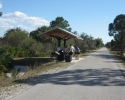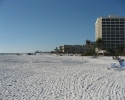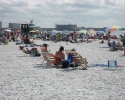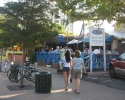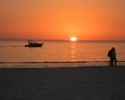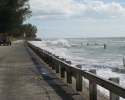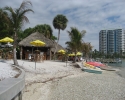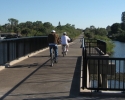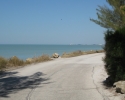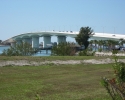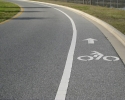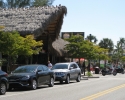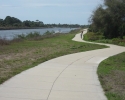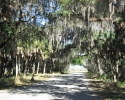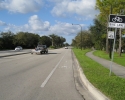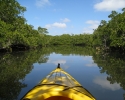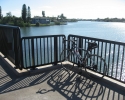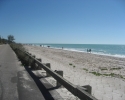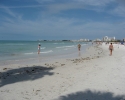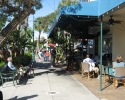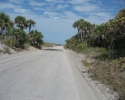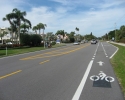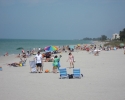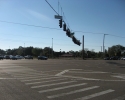Notes on going cycling in Florida
Notes on Travelling to Florida
(the Sarasota area)
for a Winter Cycling Vacation
Because of my articles about cycling in the Sarasota area, I often get questions about travelling to Florida for a winter/cycling vacation. This is an effort to provide some answers, especially for people who are doing this for the first time. It’s written from the perspective of someone travelling from Ottawa (Canada), but with a little improvisation, it could be useful for people departing from other locations.
Siesta Key (Sarasota area)
Siesta Key is a small barrier island located on the Gulf of Mexico (see map), about 112 Kilometres (70 miles) south of Tampa.
It’s my destination in Florida because the surrounding area offers a good assortment of cycling routes that generally avoids unpleasant roads with high traffic volumes. This is important because Florida can be extremely car-centric, and many areas are dominated by large roads and regional highways that are often 6 lanes, and even 8 lanes wide. These thoroughfares can be very congested, especially during the peak tourist season from mid-February to the end of March. In Ottawa, think of big-box strip along Merviale Road (only worse).
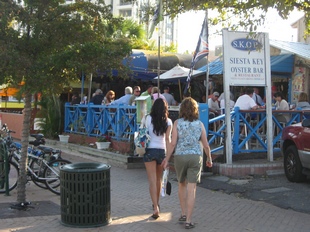
One of the bars in Siesta Key’s small downtown area.
(scroll down to the end for more photos)
I also like Siesta Key because it has its own little downtown area with a lively mix of restaurants, bars, and shops. In addition, there are a few other restaurants and stores scattered throughout the island. This means that things are generally in easy cycling distance, and maybe even walking distance. This is important because in some areas of Florida, you could end up renting a place that is surrounded by endless miles of vacation properties. In these places, if you want to go anywhere (restaurants, grocery stores) you are expected to get in the car and drive 15 or 20 minutes (often longer, when there’s traffic congestion).
If you’re a beach person, you’ll be happy to know that Siesta Key’s beach is consistently rated one of the best in all of the US (including Hawaii). The area will also provide you with some spectacular sunsets over the water, something you won’t get on Florida’s east coast. Another advantage with Siesta Key is that it is located just south of Sarasota, a smallish medium size city (the population of its entire metro area is a little over 700,000). This means it is possible to access big city amenities without the need to navigate through a super large urban environment. An aquarium, museum, and botanical gardens are all within cycling distance. It’s possible to cycle from Siesta Key to downtown Sarasota in about 25 to 30 minutes.
Florida Weather
The weather in Florida isn’t overly hot during the winter (January to the beginning of March). In fact, it can be downright cool on certain days.
For example, in February, you can generally expect to see daily highs in the low to mid-70s (22° to 24°C) in the Sarasota area. Temperatures in the high 70s and even the low 80s (27°C) are also fairly common. Conversely, it’s possible to hit a string of days when the temperature will only climb up to the mid-60s (18°C). When this happens, temperatures in the early morning and evening hours can be chilly, perhaps even cold. On average, the temperatures given above will be a touch cooler in January, and slightly warmer at the beginning of March.
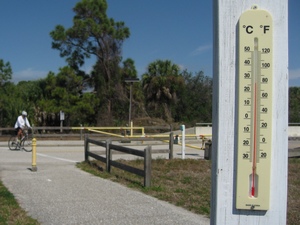
Cycling temperature.
(scroll down to the end for more photos)
One good thing about Florida weather during the winter is that it’s mainly sunny. You can get the odd cloudy day and the occasional thunderstorm that will roll through, but it’s officially the dry season, and you should see the sun most of the time. By Florida standards, the humidity level is also quite reasonable, although you can still get a muggy day every so often. From time to time, it is possible to get some early morning fog along the coastline, but this usually burns off by mid-morning at the latest. Bugs and mosquitoes aren’t really a problem during the winter months.
Florida, especially its west coast, can sometimes suffer from one deficiency that rarely makes it into the tourist brochures. It’s called a ‘red tide‘, a harmful algal bloom in the ocean that can release enough toxins in the air to affect people on the beaches or areas immediately adjacent to the waterfront. In varying degrees, people will suffer from a dry cough, throat irritation, and watery eyes, but it can be more serious for individuals with respiratory ailments such as asthma. Red tide blooms do not happen every year. When one does show up, it can affect a beach in the morning, be gone in the afternoon, or it can linger for a few days. It sometimes affect one beach, but not another a few miles up the coast. Although a red tide can sometimes be a nuisance for people on the beach, it shouldn’t have much affect on the cycling portion of a vacation.
Getting there (flying)
The easiest way to get there is to fly to Tampa and rent a car to drive down to Siesta Key (the drive is just a little over an hour). Both Westjet and Air Canada offer weekly non-stop flights between Ottawa and Tampa (as of 2017). Although there are no guarantees, a lot of people believe your best bet for getting a low rate is to book your flight approximately 2 to 3 months in advance.
If there are good flights available, flying from Ottawa to Fort Myers is also an option, although the drive up to Siesta Key will be slightly longer. Another possibility is to fly in and out of Orlando, but you will have to be prepared to drive over two hours to get to the Sarasota area.

Sunset on Siesta Key’s beach.
(scroll down to the end for more photos)
When it comes time to book your rental car, its worth looking for online coupons or promo codes. You may have to do a little searching and try a few codes, but chances are that you’ll find one that will save you a few bucks. You should be able to save a good amount by declining the car rental insurance while, at the same time, making sure you’ll be covered with your exiting automobile insurance policy. When looking at prices, check to see if they include the fees and taxes, which can account for close to 50% of the cost of renting a car. Also, be aware that when you go to pick up your car, almost all the rental agencies at the Tampa Airport will attempt to put you in a car that is more expensive than the one you booked.
It is also possible to book a shuttle taxi to get from the Tampa Airport to Siesta Key, but this can be expensive. $US80 to Sarasota, and probably a little more to Siesta Key (price as of 2017).
Most cyclists who fly down plan on renting a bicycle in Florida (more on this later). However, if you’re on a direct non-stop flight, then bringing your own bicycle may be a feasible proposition. Airlines generally charge a special fee for checking a bicycle in as baggage for each leg of a trip (and a trip with a connecting flight usually counts as two legs). With non-stop flights, you’ll only have one leg each way, so it may be possible to keep costs down. But be careful. Some airlines will try to hit you with additional fees, especially if the bike is also considered a second piece of luggage, or if it is found to be oversized and/or over weight, so it’s important to ask questions and study the fine print.
If you do decide to travel with your bicycle, try to get a cardboard box from a local bike shop, and do a Google search on how to pack everything. Remember that your rental car will have to have enough room for your bicycle. It is sometimes easier to fit the bike in a car by removing it from the box. Collapse the box and maybe fold it (keep it because you’ll need it for the return trip).
Getting there (driving)
Driving down to Florida becomes a realistic option if you are going to be staying long enough. Depending on your exact route, the distance from Ottawa to the Sarasota area is 2400 to 2500 kilometres (1490 to1555 miles), and requires approximately 24 hours of driving time. This translates into two long 12-hour days, or three 8-hour days of driving. This is only the actual driving time, and doesn’t include stops to eat, go to the washroom, fuel up the car, or simply rest. These stops will often add another 2 hours spent on the road each day.
Driving is a bit cheaper than flying, and really starts to become economical if there are two or more people to share the cost of gasoline and motel rooms. On top of this, you’ll save even more money by not having to rent a car and bicycle in Florida (assuming you’ll be bringing your bike in the car).
There are two basic routes for driving down, and both start with crossing the Canada/US border at the Thousand Islands, and heading south on the Interstate 81 (I-81) through New York and most of Pennsylvania.
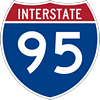
The first route (see map) is a little more direct and a little shorter, and involves turning off I-81 at Harrisburg to head east to the I-95 (a little ways north of Washington DC). You then follow the I-95 south all the way to Florida. One disadvantage with this route is that the I-95 has a fair amount of traffic and long sections where it’s a straight, monotonous, billboard littered highway. Another problem is that this route requires that you drive around Washington DC on its ring road (the I-495). Unfortunately, this ring road has a reputation for being very congested, even on weekends and during the day between rush-hour periods. Nevertheless, this route may be a good choice if you want to get to Florida as fast as possible and will be driving the northern portion of the I-95 late at night.
There is a variation to the first route (see map) that steers clear of the Washington ring road. You stay on the I-81 a little longer, and turn off at Winchester to head over to the I-95. It’s slightly longer, and while it does away with the congestion around Washington DC, it doesn’t avoid all the pitfalls of the I-95.
The second route (see map) involves driving south on the I-81 all the way to Virginia, and taking the I-77 and I-26 to head over to the I-95 (just north of Georgia). Compared to the first route, this one is less built-up and generally has less traffic, although a few sections of the I-81 can be fairly busy in parts of Pennsylvania and Virginia. This route is about 60 kilometres longer, but often doesn’t take much more time to drive because it’s less congested. A lot of the I-81 passes through the Appalachian Mountains, and some areas can be quite scenic, especially in Virginia. 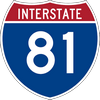 Like the first route, this one also goes through, or next to, some urban centers (Charlotte being the largest), but traffic usually flows smoothly in these areas on weekends or periods outside the peak rush-hours. The main disadvantage with this route is because a lot of the I-81 runs through mountains, there is a greater chance of being hit by snow squalls or snow storms. You have to pay greater attention to the weather forecast with this route.
Like the first route, this one also goes through, or next to, some urban centers (Charlotte being the largest), but traffic usually flows smoothly in these areas on weekends or periods outside the peak rush-hours. The main disadvantage with this route is because a lot of the I-81 runs through mountains, there is a greater chance of being hit by snow squalls or snow storms. You have to pay greater attention to the weather forecast with this route.
Regardless of which route you take, you’ll cross Georgia, and enter Florida on the I-95. Shortly after crossing into Florida, you have to get off the I-95 and spend approximately 1.5 hours on regional (non-Interstate) highway 301 to cross over to the west side of Florida to get on the I-75. Highway 301 in northern Florida bears special mention because it’s full of speed traps. When passing through some of the small towns on the 301, stay a few miles an hour under the speed limit just to be safe. Once you get on the I-75, you head straight down to the Sarasota area. To get to Siesta Key, turn right on Clark Road (exit 205).
Planning your drive to Florida
You’ll have to decide what works best for you, but for what it’s worth, here’s what we did those years when we used to drive to Florida. We generally favoured the second route (see map) because it’s a little more relaxing and scenic.

Cyclists in Florida.
(scroll down to the end for more photos)
We usually took 2.5 days to drive to the Siesta Key. The first day was our longest. We tried to make it all the way to Daleville (exit 150B) or Roanoke (exits 146 & 143) on the I-81 in the southern part of Virginia (a distance of about 1175 km or 730 miles). Our second day was a little shorter, and we tried to make it to the Brunswick area in Georgia (exits 38 & 36 on I-95), or maybe even to a motel just inside the Florida border (a distance of about 840 km or 522 miles). This left about 525 km (325 miles), or a five hour drive for our final day. This schedule put us in the Siesta Key area by early afternoon on the third day. This gave us enough time to buy groceries (usually at the Walmart on Clark Rd), before taking possession of our rental property when it became available around 3 o’clock in the afternoon.
Why take 2.5 days instead of 2 days? If we did it in 2 days, we would have arrived very late at night, and would not have made very much use of our rental unit during the first day. We would also end up using part of the next day to settle in, and do some groceries shopping. Moreover, if we unexceptedly had to extend our trip by a third day because of bad weather, or because we were simply tired, we would have had to pay a motel while our place in Siesta Kay sat empty.
For our return trip, we usually tried to make it back to Ottawa in two days, with one overnight stop around the Hillsville area (exit 14 on the I-77 in Virginia). We always kept the option open for extending our return trip by a third day in case we got tired or hit some bad weather.
When looking for a place to eat or stay when driving to Florida, you’ll generally find a cluster of restaurants and inexpensive to moderately priced hotel/motels at most major exits along the Interstate highways. You can usually count on the restaurants staying open until 9:00 or 10:00 pm. With a coupon and/or a little haggling, expect to pay $49 to $59 dollars for an inexpensive motel (such Super 8) on most weekday nights. Add $10 for weekend prices. (All prices as of 2017, and in US dollars.) It should be possible to find a room without a reservation on weekdays, but it’s probably a good idea to book in advance Friday to Sunday, especially if you plan to check in later in the evening.
You can use you smart phone to find and book a motel along the highway. If you don’t have a good data plan with reasonable roaming fees, you can connect to free wifi at some of the fast food restaurants along the highway.
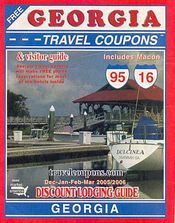
Hotel Coupon Book.
A low-tech way of finding a room is to use the hotel/motels coupon books that are widely available for each state. They are easy to use because hotels/motels are listed according to the exits along the major highways. Although these books advertise all sorts of specials, you have to read the fine print because some of the coupons or discounts only apply on weekdays or to ‘walk-ins’. You can pick up these coupon books at the ‘welcome centers’ or tourist offices that you’ll see every time you enter a new state. You probably want to stop at these for a rest and to go the washroom. (I always ask the tourist officials for information about cycling in their state.)
It’s worth noting that gasoline is generally more expensive in New York & Pennsylvania, and cheapest in parts of Virginia and most of the Carolinas. Prices start to climb up a bit in Georgia and Florida. Some places (mainly in Georgia) post deceivingly low gas prices which only apply to ‘cash’ sales. The price will be higher when paying with a credit card. You should also know that Americans usually have to enter their five digit ZIP Code when paying at a gasoline pump with a credit card. This poses a problem for Canadians. Fortunately, you can enter the three numbers from your Postal Code, followed by zero, zero. For example, if your Postal Code is “K1N 6N5“, enter “16500“. This works in most places, but not everywhere.
Accommodations (finding a place to stay)
This is the downside of Florida vacation during the winter. Gasoline and groceries are a little cheaper in Florida, and the cost of eating out is about the same, even with the unfavorable exchange on the Canadian dollar. Unfortunately, this is where the good news ends. There’s no nice way to put it: the cost of accommodations in most areas of Florida range from expensive to very expensive, and this situation is made worse when the Canadian dollar in down in the dumps.
Rental properties in many of Florida’s resort areas consist of apartments, condos, or, in the parlance of the local tourist industry, villas. Some are studios with kitchenette and small eating areas, but most come with a living room, one or two bedrooms, a fully equipped kitchen, and often, a shared laundry facility. Many provide access to a swimming pool, and most (but not all) are within reasonable walking distance to the beach. Many are listed on websites such as Vacation Rentals By Owner (VRBO), Vacation Home Rentals, or local rental agencies, such as Siesta4Rent, in the case of Siesta Key.
The problem is that the more reasonably priced (but still expensive) units are booked months in advance, often a year in advance. Moreover, when people find a good property, they often come back year after year, so it can be a decade before some units come on the market. This makes for slim pickings. Nevertheless, you should be able to come up with something interesting if you conduct a thorough search well in advance of the date when you plan to go. There is also a steady stream of units that become available throughout the year because of cancellations, but to catch any of these, you’ll have to check the website listings on a regular basis. Anything really good will be snapped up very quickly. You should also check directly with resort operators. They may have units available that are only listed on their websites.
There are a few things to keep in mind when conducting your search. When you see a price range for a unit, always assume you’ll be paying the higher amount if you plan to book the place during the winter months. Some private owners leave the ads up even when their units are fully booked up. A few of these owners are not even courteous enough to reply to your email enquiries about the availability of their properties. And finally, when you first look at some of the listings, especially later in the season, you may be shocked by the prices. However, most of these are the leftovers of the very expensive units. They remain available for people who are willing to pay top-dollar for getting something at the last minute.
Except for a few hotels, most tend to be located just outside the resort areas near the beaches and along the coastline. If you are taking a short vacation, and can find a hotel that is close enough, it’s an option worth considering (there seems to be a little more availability with hotel rooms). Whatever the case, it never hurts to see what you can come up with Booking.com and AirBnB.
It is also possible to keep costs down by renting a condo on the mainland. This means you could be in an urban area a mile or two from the beach, and this may clash with your idea of a resort inspired Florida vacation. If you do consider such a property, use street view on Google maps to check out the neighborhood, and to make sure you will not be surrounded by multilane roads which will hamper your ability to walk or cycle anywhere.
A few last points to help orientate yourself if you do decide to rent on Siesta Key. There are a couple of public access points to the beach where Stickney Point Rd meets Midnight Pass Rd. There is also a small cluster of restaurants, bars, and stores in this area. There are a good number of public access points to the beach towards the north end of the island (along Beach Road). Siesta Key’s small downtown (the Village area) is also located on the northern part of the island, on Ocean Boulevard.
If you do consider a property in Siesta Key on the east side of Midnight Pass Road (the main road that runs down the middle of the island), be sure to ask about private access to the beach, because in some areas you may have to walk a good distance to get to a public access point. This should not be an issue when renting on the west side of Midnight Pass Rd. Also note that the part of Siesta Key south of Stickney Point Road tends to be a little more isolated. There’s nothing wrong with it, but you’ll have to pedal an extra distance to get to many of the island’s restaurants and pubs, Siesta’s main beach, or to bridges that lead to the mainland.
Renting a bicycle
If you are going to be flying down, you’ll probably want to rent a bike once you get to Florida. There are full fledged bike shops in the Sarasota area that will rent a good quality aluminum road bike with 105 components for $50 a day, or $175 a week, and $250 a week for a high-end bike with a carbon fiber frame.
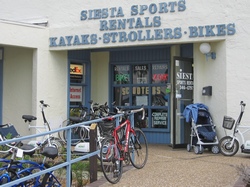
Bike rental in Siesta Key.
(scroll down to the end for more photos)
This is getting a little expensive. Fortunately, there are two places in Siesta Key (near Stickney Point Road) that rent out all sorts of tourist paraphernalia, including beach chairs, strollers, kayaks, paddleboards, and, of course, bicycles. Most of what they rent out are single speed beach cruisers or inexpensive hybrids, but they do have some true road bikes (drop bar models) at relatively reasonable prices.
Siesta Sports Rentals has some entry level road bikes that they rent for $90 a week (there may be some leeway with the price when renting two or more bikes prior to the really busy season, which begins in mid-February). Siesta Key Bike and Kayak is located just around the corner, they have road bikes that may be a touch better for $100 a week. They also offer some carbon fiber bikes for $150 a week. If you really you want to keep cost down, it’s always possible to get a basic multi-speed hybrid at either place for $45 a week (all rental prices as of 2017, and in US dollars).
These places only have a limited number of frame sizes in the drop-bar road models, so it is best to book in advance, especially if you are going to need this type of bicycle in the latter half of February or the beginning of March.
When renting a bike, you will likely be supplied with an old helmet, a cable lock, a spare tube & tire levers, and maybe something that might pass for a portable air pump. Whatever the case, I recommend bringing your own helmet, as well as a few basic tools, water bottles, and a good quality portable pump. People with a sensitive posterior may wish to bring their own saddle. If you use them, don’t forget your clipless pedals and shoes. It’s also a good idea to take the bike-fit measurements off your existing bike so that the rental can be set up as quickly as possible.
I don’t recommend doing any real nighttime riding in Florida. However, you will probably ride a short distance on the local roads in Siesta Key in the evening when returning from a restaurant in the Village area. So bring your bicycle LED lights (depending on when you’re there in the winter, it gets dark between 6:15 and 6:30).
Cycling in Florida
When it comes to cycling, Florida is full of contradictions. It doesn’t take long to realize that the place is extremely car-centric, and yet, Florida has many more bike lanes than what is typically found in Ontario. Drivers are allowed 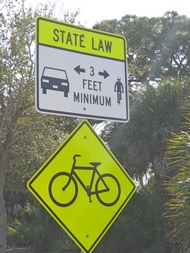 to use hand held cell phones in Florida, and yet, the state had a 3-foot passing law before Ontario (although it is rarely, if ever enforced).
to use hand held cell phones in Florida, and yet, the state had a 3-foot passing law before Ontario (although it is rarely, if ever enforced).
It can sometimes be difficult to anticipate how motorists will interact with cyclists. With so many tourists from various jurisdictions throughout North America, drivers bring with them both the bad and good practices of their home states or provinces. Some are courteous with cyclists, while others threat them as if they don’t belong on the road. Moreover, as a popular retirement destination, Florida has more than its share of elderly drivers. Local cyclists joke that “It’s not the grandparents you have to worry about, it’s the parents of the grandparents that you have to watch out for”.
Cycling on the sidewalks is legal in Florida, but banned in many municipalities. Whatever the case, tourist areas are often littered with sidewalk riders. My guess is that most of these are consummate motorists who thought it would be nice to rent a bike and do a little pedalling during their vacation. Since they believe that cyclists belong on the sidewalks, this is where they go riding, even when there’s an adjacent bike lane. On more than one occasion, I have witnessed pedestrians walking in the bike lane while people where cycling on the sidewalk.
One of the big challenges for cyclists is dealing with (or avoiding) the large multi lane congested roads that seem to infest many areas of Florida. Trying to use the ‘vehicular cycling‘ technique to turn through an intersection involving these types of roads would not be for the faint of heart. Motorists would not expect to see, nor be on the look out for cyclists in such circumstances.
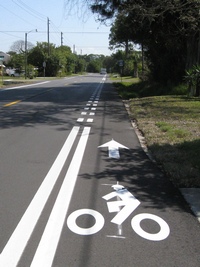
Bike lane in Florida.
(scroll down for more photos)
Despite these idiosyncracies and challenges, Florida isn’t all that bad a place for cycling. For one thing, you don’t have to worry about any ice or snow. If you don’t like hills, most of Florida is flat, as in very flat. More importantly, it’s possible to find large areas where cycling is not only practical, but also a relaxing and enjoyable activity. In these areas, you can map out extended cycling routes on roads that often have paved shoulders or bike lanes, and that minimize contact with the busy multi lane thoroughfares. Confirmation of this can be found in the fact that the Sarasota area has numerous large and well stocked bike shops and several bicycle clubs. It is quite common to see group rides as well as solo cyclists on many of the local roads and pathways.
The Sarasota Manatee Bicycle Club is one of the area’s well established clubs. It’s worth mentioning because non-members who sign the necessary waiver are allowed to join many of their rides (as of 2017). The club offers rides everyday of the week in a variety of speed ranges. The starting points for some of these rides are within cycling distance of Siesta Key. Just remember that when a ride is advertised as having an average speed of 25 mph, that’s really 40 km/h.
So that’s it. Hopefully you now have everything you’ll need to plan a winter-get-away cycling vacation in Florida. (Don’t forget the sunscreen.)
Michael McGoldrick
March, 2017
[feather_share]
 Florida’s Legacy Trail The Legacy Trail is just what the doctor ordered if you’re looking for a relaxing ride on Florida’s west coast (especially for winter refugees).
See downtown Sarasota, Lido Key, St. Armands Circle, Longboat Key, and Anna Maria Island all in one ride that crosses several islands.
Myakka River State Park is one of Florida’s oldest and largest, and it’s ideal for anyone who wants to head inland for an extended ride. |
Various photos from around the Siesta Key/Sarasota area.
(Click on the images for larger photos)

